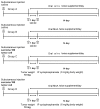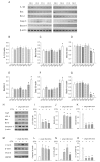Soy-Based Multiple Amino Acid Oral Supplementation Increases the Anti-Sarcoma Effect of Cyclophosphamide
- PMID: 27043621
- PMCID: PMC4848661
- DOI: 10.3390/nu8040192
Soy-Based Multiple Amino Acid Oral Supplementation Increases the Anti-Sarcoma Effect of Cyclophosphamide
Erratum in
-
Correction: Yao, C.A., et al. Soy-Based Multiple Amino Acid Oral Supplementation Increases the Anti-Sarcoma Effect of Cyclophosphamide. Nutrients 2016, 8, 192.Nutrients. 2020 Sep 8;12(9):2732. doi: 10.3390/nu12092732. Nutrients. 2020. PMID: 32911614 Free PMC article.
Abstract
The use of a mixture of amino acids caused a selective apoptosis induction against a variety of tumor cell lines, reduced the adverse effects of anti-cancer drugs and increased the sensitivity of tumor cells to chemotherapeutic agents. We evaluated the effects and underlying mechanisms of soy-derived multiple amino acids' oral supplementation on the therapeutic efficacy of low-dose cyclophosphamide (CTX) and on tumor growth, apoptosis, and autophagy in severe combined immunodeficiency (SCID) mice that were injected with sarcoma-180 (S-180) cells. 3-methyladenine or siRNA knockdown of Atg5 was used to evaluate its effect on sarcoma growth. A comparison of mice with implanted sarcoma cells, CTX, and oral saline and mice with implanted sarcoma cells, CTX, and an oral soy-derived multiple amino acid supplement indicated that the soy-derived multiple amino acid supplement significantly decreased overall sarcoma growth, increased the Bax/Bcl-2 ratio, caspase 3 expression, and apoptosis, and depressed LC3 II-mediated autophagy. Treatment with 3-methyladenine or Atg5 siRNA elicited similar responses as CTX plus soy-derived multiple amino acid in downregulating autophagy and upregulating apoptosis. A low dose of CTX combined with an oral soy-derived multiple amino acid supplement had a potent anti-tumor effect mediated through downregulation of autophagy and upregulation of apoptosis.
Keywords: Atg5; apoptosis; autophagy; chemotherapy; mice; soy-based amino acids.
Figures





References
-
- He Y.H. General survey of traditional Chinese medicine and Western medicine researches on tumor metastasis. Chin. J. Integr. Med. 2006;12:75–80. - PubMed
-
- Pihlak R., Liivand R., Trelin O., Neissar H., Peterson I., Kivistik S., Lilo K., Jaal J. Complementary medicine use among cancer patients receiving radiotherapy and chemotherapy: Methods, sources of information and the need for counselling. Eur. J. Cancer Care. 2014;23:249–254. doi: 10.1111/ecc.12132. - DOI - PubMed
-
- Somasundaram S., Edmund N.A., Moore D.T., Small G.W., Shi Y.Y., Orlowski R.Z. Dietary curcumin inhibits chemotherapy-induced apoptosis in models of human breast cancer. Cancer Res. 2002;62:3868–3875. - PubMed
Publication types
MeSH terms
Substances
LinkOut - more resources
Full Text Sources
Other Literature Sources
Medical
Research Materials

